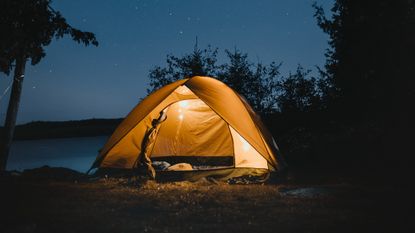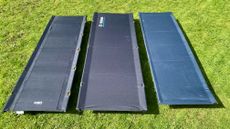Camping has been enjoying a boom in popularity since the start of the pandemic. Because there are so many incredible camping spots in the UK, it's a (relatively) easy way to enjoy a break without having to worry about changing travel rules. The al fresco approach to holidaying means less stress about mixing with other potentially virus-ridden holidaymakers in a confined space, and less chance your accommodation will cancel due to staff shortages or an unexpected outbreak.
Many assume that camping is a bargain holiday option, and while that's to some extent true, the initial outlay to get hold of all the equipment you need can mean that first camping trip is pricier than you'd expect.
The most expensive thing on your to-buy list, unless you buy an absolutely mad sleeping bag or something, will be your tent. Getting the best bang for your buck is a tricky balancing act; go too cheap, and chances are it'll put a major dent in your comfort levels (camping is great, but not if there's damp leaking in from the groundsheet and the poles are bending in the wind). Go too pricey, and you'll need to camp a LOT to see the cost per use become worth it. And with the price of just about everything shooting up at the moment, who can afford to 'go too pricey' anyway?
There are plenty of recommendations in our best backpacking tent and general best tent lists, all of which offer excellent quality for the price. But for some more advice, we spoke to the experts from two major UK tent retailers to find out their top tips for getting the best value tent for the summer.
1. Wait until the end of the season to buy
“Generally speaking, the best time to purchase a tent is at the start of a new season, when stocks are replenished and there’s a wide variety of options to choose from. This would normally be around the end of March time, ahead of the Easter holidays," says Jack Kelly, an outdoor expert at Millets. "If you are a bargain hunter, however, you may wish to wait until the tail end of the season, when sales typically take place." So if you're quick you might be able to pick up some bargains right now, or if not you'll perhaps need to wait until the end of the summer, when no one wants to go camping any more. In recent years we've also seen some decent tent deals over the Black Friday weekend, which falls at the end of November.
2. Prioritise waterproof-ness
One thing to prioritise, for fairly obvious reasons, is the tent's waterproof rating. This is called the 'hyrdrostatic head' (HH), and is measured in millimetres. Values will typically range somewhere between 1,000mm and 10,000mm. "It’s worth investing in a tent with a mid to high waterproof rating to cover you for all excursions and save you buying another down the line," suggests a spokesperson from the Mountain Warehouse buying team.
3. Approach pop-up tents with caution
Right at the cheapest end of the market, you'll find pop-up tents. For very casual camping, these might do the trick. However, approach with caution, because even today's best popup tents have their drawbacks. "Pop-up tents are often single skinned, meaning they may not be as waterproof as other tents. Due to their lightweight nature, they may also be susceptible to damage," warns Jack. Going for a single-skinned option also means you'll probably end up having to deal with condensation in the mornings.
Jack suggests they're a good choice for festival camping, because they're so quick and easy to pitch. You'll find more options in our dedicated best festival tent guide.
4. Extend your tent's lifespan with reproofing spray
To extend the life of your tent, it's worth investing in a tent reproofing spray, like this one from Mountain Warehouse. "Over time, and with use, mud and dirt can cause the water repellent coating of tents to break down, which can result in water getting inside the tent," says the Mountain Warehouse spokesperson. "We recommend periodically ‘reproofing’ the material, which will restore the repellent properties of the tents whilst maintaining breathability. This handy trick will make your tent last a lot longer.”
5. Invest in geodesic for inclement weather
There are a bunch of different tent types, suited to different types of camping. When choosing, a key thing to think about is when you'll be camping, and the kinds of temperatures and weather conditions the tent will need to cope with (this is a major element in how comfortable you'll be).
Most people think of camping as a fair-weather holidaying option, but if you want to be able to head out in dodgier conditions, you'll want to tailor your tent structure to match. "Backpackers who endure harsh weather are best suited to geodesic and semi-geodesic tents. These tents have crossing poles which create a freestanding shape and allow the tent to keep stable and rigid," explains Jack. "Geodesic tents provide excellent protection against high winds. Semi-geodesic tents are ideal for less severe conditions."
6. Leave some space for luggage
Alongside weatherproof-ness, another aspect that will have a big impact on your comfort levels is how much space there is. Trying to sleep whilst crammed in with a damp, smelly backpack and pair of boots is pretty grim. To avoid that, Jack says you shouldn't just go on the listed berth when choosing your tent. "A four-man tent will fit four people, but it won’t provide much extra room for your equipment," says Jack. "We advise that you go 1 or 2 berths above what you need to prevent it from getting too snug." Pay attention to things like whether there's a porch space, too, as this can be invaluable for stashing muddy footwear and the like.











